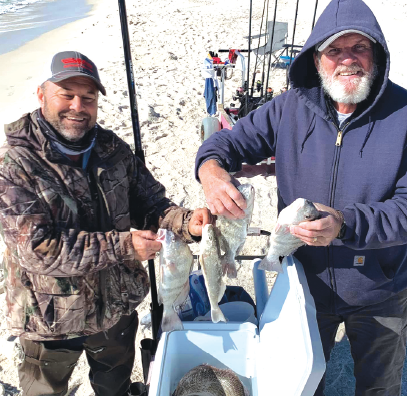Pier & Shore Fishing Outlook 11-30-2022
 Pier & Shore Fishing Outlook
Pier & Shore Fishing Outlook
By David “The Pierpounder” Thornton
Recent cool snaps have cooled water temperatures in the Gulf and especially the shallow back bays. The surf temperature has been running a few degrees below average for early December (upper 60s), with indications that may be relatively stable or even rise a couple of degrees if mild weather persists. The National Weather Service predicts we can expect seasonable temperatures and slightly drier conditions to persist into mid December. That means the current fall fishing pattern may well persist through this fortnight, interrupted by passing fronts about once a week.
We have still been seeing some “bull reds” caught at Fort Morgan Point and near Perdido Pass at times. Look for diving pelicans to indicate where the big fish are driving schools of Gulf menhaden (pogies) toward the surface or into the shallower surf zone.Bluefish and Little Tunny (bonita) and even a few small spanish mackerel may show up within casting distance for anglers on the west jetty at Perdido Pass too. A one to two ounce silver spoon should get their attention, but they might be caught on any number of jigs, spoons or plugs. Especially when your offering matches close to whatever forage fish they are feeding on.
In the meantime look for slot-sized redfish or sheepshead by drifting live shrimp or dropping fiddler crabs near the rocks or seawall. Pinfish, pigfish and other incidental bycatch fish are still a problem in the pass at times, but more of the target species are available now too.
The NEAP tide period around December 2nd may offer easier fishing in the pass because there should be less current then. But stronger tide fluctuations through the following week should offer more opportunities for beach, pier and back bay anglers to fish the incoming tide in the afternoon/evening period. This will be coincident to the full moon on December 8th and perhaps expend the evening bite until after sundown. That lends to better conditions for wade fishing inside the mouth of Little Lagoon for speckled trout. The MirrOlure MirrOdine and Heavy Dine are ideal hard lures to through for speckled trout. Also, keep in mind that flounder are again legal to harvest in December.
A few pompano (mostly “undersized”), and perhaps even a stray permit or palometa and an increasing number of large black drum should be available to surf anglers during the period. And we have been seeing more gulf kingfish (whiting) in the surf recently, though many are under 10 inches long. Not much meat on those, but whiting over 12 inches are more fun and certainly meatier. But it takes a couple of years for them reach that size, so it is probably best for the fishery to release those under 12 inches so they may spawn at least once. Whiting numbers have been only a fraction from what we saw just a couple of years ago and localized depletion from over harvesting them along the Gulf Shores, Orange Beach and Perdido Key areas may be a major contributing factor. They have even been quite scarce from the Gulf State Park Pier this fall, and that is usually a hot spot for whiting in December.
Another factor plaguing from shore anglers this fall has been the frequency of unusually calm surf. Often the wave action has been almost nil for days at a time until a front is bearing down on the coast and the wind is blowing at near gale force for a couple of days. Conditions most conducive to fish feeding along or just off the shore would be moderate winds (10-15 miles per hour) and one to three foot surf. In cooler water calm or too rough is just good for fishing. As we get closer to winter time, the frequency and strength of cold fronts increases, all the while water temperatures slip downward.
The banks along the Intercoastal Waterway offer refuge from raging surf along with a fair probability of wrestling with huge black drum. These canal drum are usually over 30 inches long (about 15 pounds) and commonly reach 40 inches or even more (25 to 30 pounds). Occasionally “bull” red drum are caught in the same locations and with the same methods. Most often that is baiting up a ½ blue crab or chunk of fresh cut mullet fished on the bottom. The canal depth is maintained at 12 feet, and is deeper in some spots. Fishing along those edges seems to get the most action, though in warmer weather these big drum move into shallower water near the bank to feed among the rocks on small crabs. Heavy to medium heavy spinning tackle in the 15 to 30 pound class is most often employed with reels in the 4000 size up to 6000 size and rods 7 to 12 feet long. At times the current can run deceptively swift in the canal. So weights of 3 or 4 ounces may be needed to keep your bait in place or your terminal rig may be swept into the numerous snags on the bottom.
Pictured: Mark (from Saraland) and Don (from Orange Beach) caught several fish species with Jordan Gooding. Photo by G2Coastal


 Pier & Shore Fishing Outlook
Pier & Shore Fishing Outlook